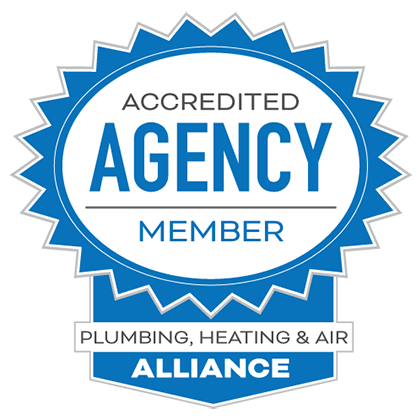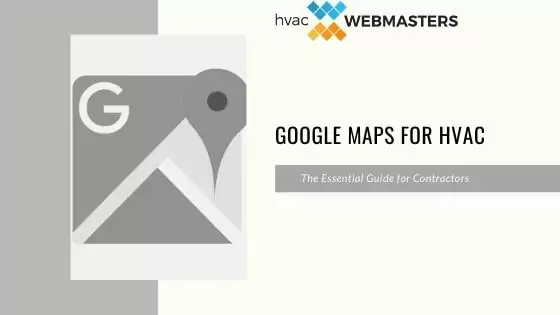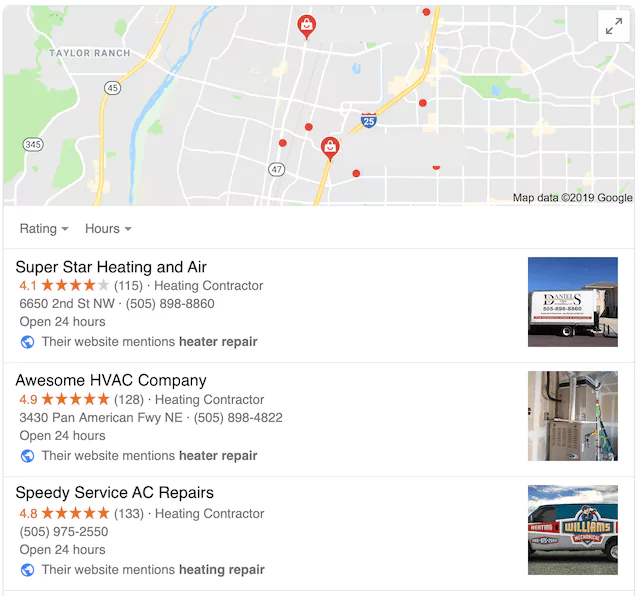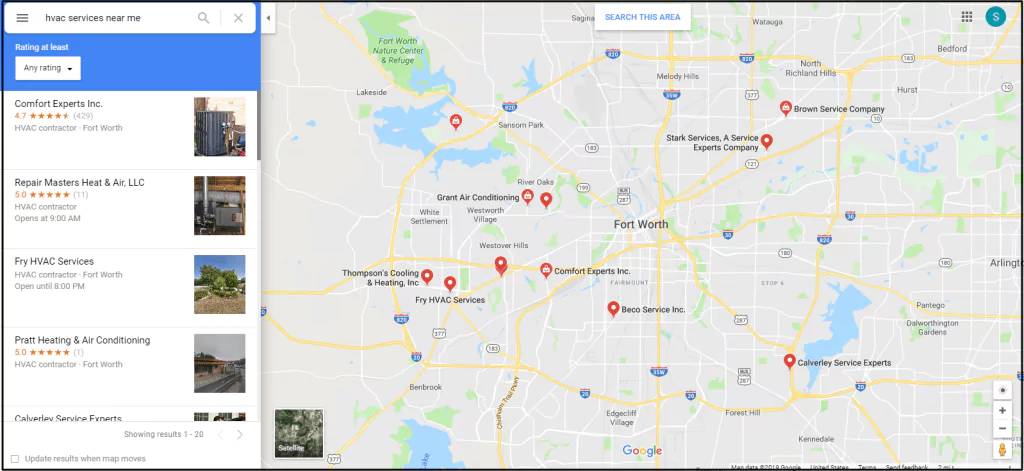Over my 14+ years crafting and executing Local SEO campaigns for professional HVAC companies, much has changed, from algorithm updates to consumer search behavior.
One thing that has remained constant is the value of appearing on search results for local queries like hvac company near me.
I’m Nolen Walker, the founder and CEO of HVAC Webmasters. Based on my 14+ years of experience as an SEO agency owner, I’ve written the ultimate guide to Local SEO for HVAC companies.
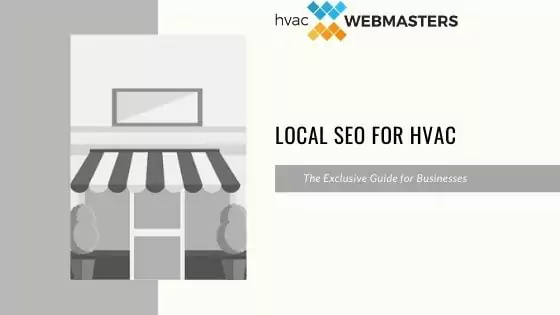
Local SEO’s Impact on HVAC Companies
Local SEO for HVAC is the practice of optimizing your HVAC business for local searches on Google and other search engines.
Specifically, the practice targets Google Map 3-Pack rankings with your Google Business Profile and regionally-targeted landing pages for traditional organic results.
Local SEO encompasses various SEO practices, including NAP citations, Google Business Profile, and local website landing pages for HVAC companies.
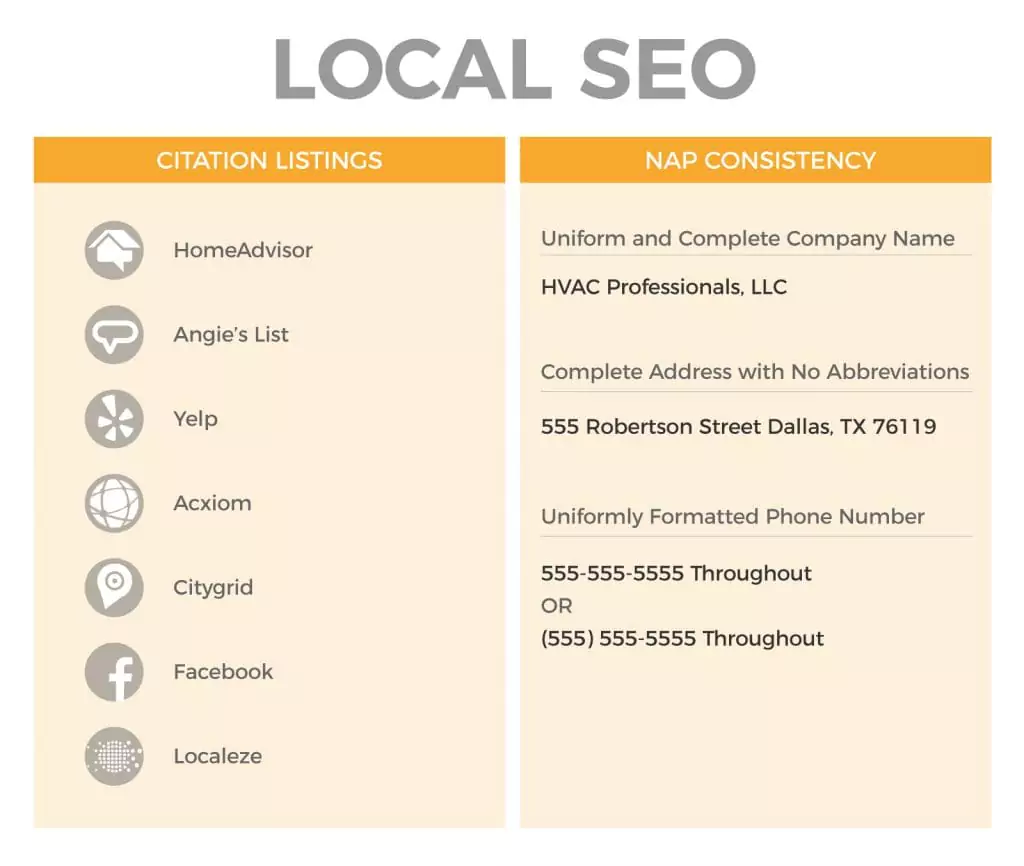
Why HVAC Companies Need Local SEO
Local SEO is tremendously important, given how potential clients typically search for your heating and air services (by location). Over the past decade, my agency, HVAC Webmasters, has worked with thousands of contractors, producing favorable local SERP results.
Check out some of my agency’s case studies to learn more.
Not only should your organic on-page and social media content include a focus on local keywords that rank well for geographic factors, but there are additional elements to local SEO that you can employ to help search engines like Google recognize where you are.
This is what ensures you’re prominently displayed in SERPs. Some of the local SEO elements that a strong internet marketing plan will include:
- Citation Management
- Google Business Profile management
- Embedded Google Maps on Contact Page
- NAP Consistency
- Review Management
- Schema Markup
You don’t have to know how to execute these variables yourself to have a successful HVAC website.
However, you need to leverage experts in local SEO (like us) who can dial in all the pieces of the puzzle to make your site look strong and logical when Google retrieves location-specific results for users.
MOZ listed these (and several other factors) when considering local search ranking results, and it’s worthwhile to consider that some elements weigh more heavily than others when moving the dial on your SERP position.
Google Map 3-Packs appear at the top of SERPs for most local queries like hvac contractor near me, ac repair services near me, and various other phrases.
Local SEO Ranking Factors for HVAC
Once HVAC companies understand the importance of ranking locally, they naturally wonder how to influence rankings.
Google Maps and Google Search rankings are based on separate algorithms, so each will require unique solutions. That said, some aspects of each algorithm carry over to the other one.
Below, I will outline local SEO ranking factors based on first-hand experience with hundreds of HVAC companies. Mastering each factor gives your company the best chance to rank on both Google Search and Google Maps.
Though Google’s algorithm continuously evolves, it is important to establish a baseline of best practices for consistent growth in your industry.
Google My Business
Claiming and optimizing your GMB listing is critical to local SEO. You can claim your business here and start ranking on the Local Map 3-Pack. Of course, optimized listings perform far better than empty ones.
You should ensure accurate contact information, upload unique photos, and provide answers to the FAQ. You should also enter your website URL in the appropriate GMB field.
Google My Business, now known as Google Business Profile, serves as your local SEO foundation. Without a listing, ranking becomes implausible. Sometimes, HVAC companies have more than one listing, so you should merge the two listings.
Furthermore, it would be best if you decided whether to list your address publically since most HVAC businesses are quality as service area businesses (SAB). Your GBP listing will also serve as a central hub for your Google Reviews, which we will discuss below.
You can share your review link, email signature, and other promotional content in your marketing materials. Google Business Profile reviews have the greatest influence over Google Maps rankings and increase GBP conversions.
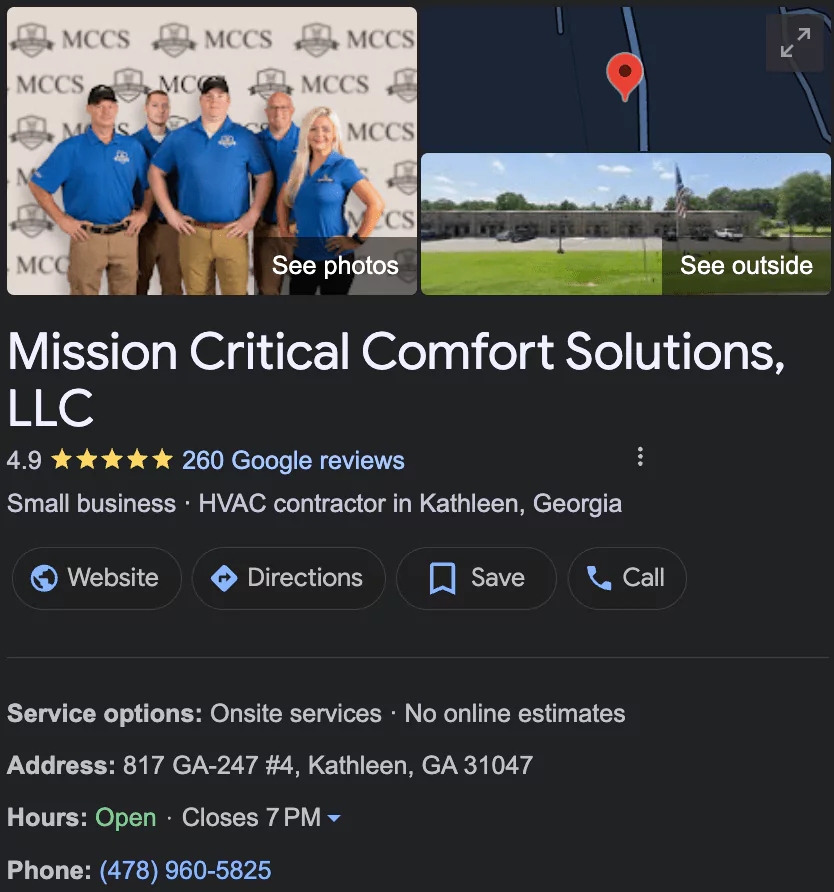
Google Reviews
Generating Google Reviews is critical to HVAC companies’ local SEO success. Google makes it easy to share your review form by providing you with a shortlink, which you can then share with customers.
Still, HVAC companies often forget to stay on top of the review generation process. Investing in a local SEO tool like DataPins solves the problem for good.
DataPins sends automated review requests to customers after finishing jobs. When customers leave Google Reviews, your company gains more credibility and converts more prospects.
In addition to requesting reviews, DataPins also empowers contractors to perform jobsite check-ins.
If you provide enough service, customers may eventually leave negative reviews. A few negative reviews won’t hurt your business, but responding to each review makes sense.
If they decide to return and use your company, try to remedy their problems and ensure great service. Remember that prospects are watching how you react to every review.
DataPins
The DataPins tool does more than just increase review request conversions. The app also helps HVAC companies rank for more keywords on Google Maps and the Google Map 3-Pack.
One of the most significant ranking factors on Google’s Map 3-Pack is the content on the associated website.
Each Google Business Profile contains a field where the business can enter its website URL. When that website features DataPins, it powers the entire Google Business Profile.
The Map 3-Pack algorithm can now detect the various services you offer (via DataPins captions) and the areas where you performed the jobs.
3rd party studies have confirmed that nearly 50% of all search queries are undetectable, with a large portion of those being long-tail keywords.
For example, a string of words like american standard air conditioner repair service in hershey pennsylvania is not something you can find on keyword research tools. Still, it represents the type of query that drives visitors to your Google Business Profile.
NAP Citations
The terms “NAP” and “Citations” are often used interchangeably, but the best way to understand them as critical elements for local SEO is to look at what they represent: Name, Address, and Phone (N.A.P.).
It’s a no-brainer that potential customers searching for local HVAC businesses via Google will want easily accessible contact information.
Especially if the issue is emergent—such as a broken furnace in the middle of winter—a viewer needs to be able to find your phone number in seconds to schedule a repair!
NAP data is important for user experience, demonstrates to Google that your site is well-developed and useful, and explicitly communicates contact information.
This makes you a great fit for searches that invoke your stated service area (determined via location keywords or the address listed), which means Google and other search engines will give your site higher rankings to meet the need.
NAP is important for your primary HVAC website SEO—including on-page content, a thoughtfully designed Contact Page, structured data usage—and your secondary websites.
Think of social media business pages, Google Business Profiles, directory listing pages, etc., which are the citations for your HVAC business.
All of these potential entry points are opportunities to provide a great user experience by ensuring NAP is consistent, the pages are optimized, and you’ve managed citations across the web.
This establishes authority and reliability regarding your overall web presence, giving your local SEO game a huge boost.
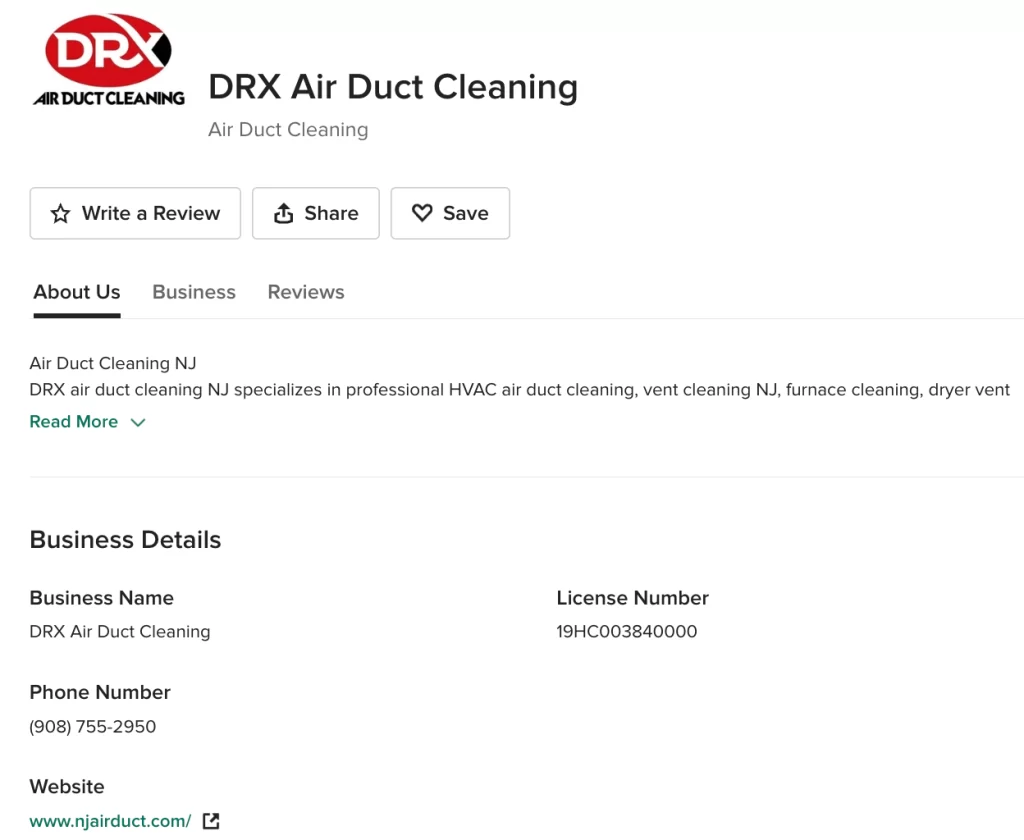
Local SEO Content
Organic content has a significant, long-term impact on your ability to rank well for local SEO. For Localized Organic Ranking Factors, the on-page signals count for 26% of your ranking score.
What does this mean? It’s (hopefully) no surprise at this point that you need high-quality copywriting on your website.
You can’t put a single paragraph on a webpage about HVAC services and expect that to inform your potential customers in any meaningful way, nor will it reward you with a top spot on the search engine results page.
I will go ahead and beat this point to the ground: Google wants what your site visitors want.
When potential customers click through to your website from the results page or a citation page, they expect to find relevant info. There is no value if you have generic or lackluster content or minimal content volume.
You’re not adding anything worth reviewing; thus, you aren’t considered an optimal candidate for Google to serve up in the rankings.
We know that quality content is necessary for HVAC businesses, but incorporating location keywords into the content will impact local SEO.
It’s one thing to kick butt for the keyword search “best heating company,” but if the user follows suit with typical behavior, they’re going to tack on their city name or zip code to get more tailored results.
In fact, Google often prompts adding “near me” or even the user’s city (based on location services). You will not seem relevant if you haven’t optimized your service area (or areas).
Utilizing strong H1 tags with the city name alongside high-performing search keywords will help your site make leaps in bounds.
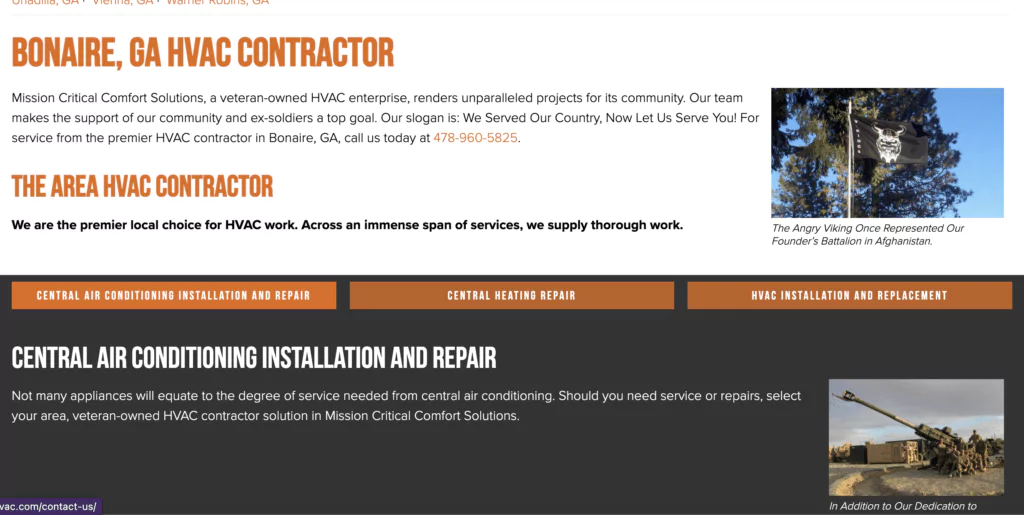
Domain Authority
Another factor to consider is Domain Authority. In a nutshell, MOZ’s metric, domain authority, is a 1-100 ranking that can help gauge the strength of your site relative to other trusted domains via links.
This means outgoing links to reputable organizations (such as unions, trade organizations, libraries, etc.) and incoming links that establish your content as traffic-worthy.
This doesn’t mean you should engage in shady linkback tactics. Instead, it reinforces an organic SEO strategy that acknowledges good content, providing value for the internet and those who use it, as the lynchpin of an effective internet marketing campaign.
Receiving links to your website from nearby organizations can bolster your local reputation and cultivate relationships.

User Experience
User experience always counts. If your site’s bounce rate is high—which means that viewers aren’t spending much time on pages—Google interprets that as less-than-engaging (perhaps due to superficial content or slow page loading) and will penalize sites that don’t seem to grab users.
On the other hand, mobile websites with a strong response via clicks to call will be perceived as helpful and relevant.
Content and information must be good, accessible, and accurate. However, you must also ensure that all typical user experience elements are intact.
This includes:
- Engaging Design
- Intuitive Site Navigation
- Obvious “Call to Action” Buttons
- Optimized Image Size For Device
- Prompt Page Loading
A strong website UX contributes to local rankings, just like SEO in general. Click-to-call buttons are especially helpful to local consumers.

Local Keyword Optimization
Local keyword optimization is not unlike traditional SEO but focuses on local terms and phrases. Company websites will still want to follow standard optimization protocol, as the best practices remain valid when crafting a local keyword strategy.
My agency, HVAC Webmasters, is a leader in online marketing for heating and cooling companies. I’ve worked with contractors in this industry for decades and know what it takes to market effectively to their core audience.
Local keyword optimization consists of the following:
- Body Content: Distribution of local terms throughout the body text
- Meta Descriptions: Inclusion of local phrases within web page meta descriptions
- Title / Header Tags: Placement of local keywords within title and header tags
- URL Slugs: Disposal of local terms within URL slugs
Optimizing for local terms using the WordPress content management system is straightforward and intuitive.
With WordPress, website managers can easily manage title and header tags, body content, and URL slugs. Internal linking is another tactic that emphasizes HVAC keywords.
Link to your most important pages from other internal pages, and use the anchor text for the keyword. Of course, ensure that your terms make sense to the reader and never engage in spammy keyword placement.
Keyword research for local SEO can yield lower search volumes with lower difficulties. Remember that many local queries don’t register volume on research tools but still drive traffic to your website and GBP.

E-E-A-T
Experience, expertise, authoritativeness, and trustworthiness are characteristics that Google looks for in local HVAC websites.
These principles are becoming increasingly important because of the new search generative experience and the emergence of AI-driven content technology.
HVAC websites can demonstrate E-E-A-T in various ways, including an informative About Us page, an embedded review slider featuring verified feedback from Google My Business, Yelp, and other trusted sources, and showcases of recent jobs (like pins and check-ins from DataPins).
Check out each letter of the acronym below:
- Experience: Demonstrate hands-on experience with HVAC services
- Expertise: Convey expert status related to the HVAC industry
- Authoritativeness: Earn endorsements (links, mentions, etc.) from other credible sources
- Trustworthiness: Accumulate and showcase customer feedback, primarily through reviews
E-E-A-T considers more than just your website because it looks at its relationship to other digital entities like your Google My Business profile or your Facebook Business page. As a result, it’s important to invest in a comprehensive branding strategy for your digital presence.
Making The Most of Local SEO for HVAC Companies
Local SEO is crucial to your online presence as an HVAC company. Most of your target consumers will search queries like ac repair near me and view the results within the Local Map 3-Pack. As a result, it’s vital that your listing appears within the pack.
The techniques above, including citations, GMB optimization, review generation, and DataPins, are each essential to ensuring local map rankings.
Beware of misinformation regarding local search optimization for HVAC contractors. Ensure your sources have experience and expertise.
For example, I’ve provided digital marketing services to heating and cooling companies for over a decade at my agency, HVAC Webmasters.
My entire process is dedicated to helping you rank for local terms on Google and other search engines.


